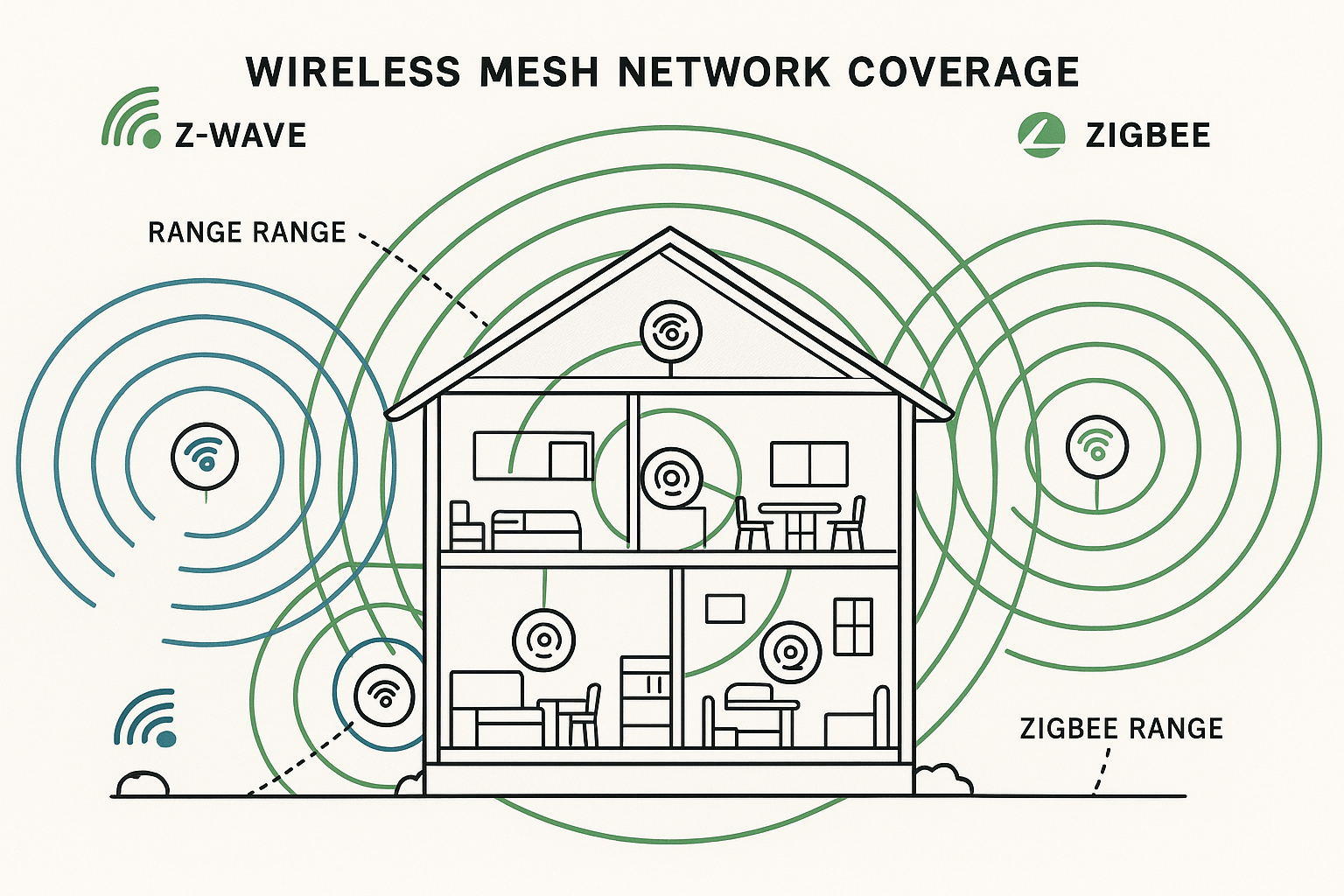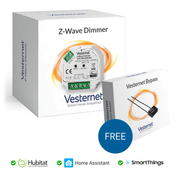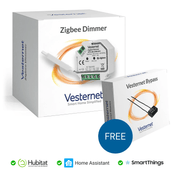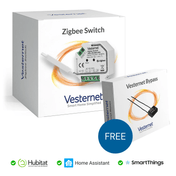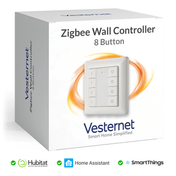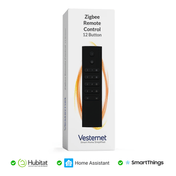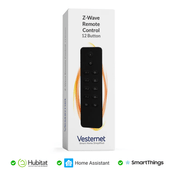Understanding the realistic range capabilities of Zigbee and Z-Wave mesh networks is crucial for designing reliable smart home systems. While both protocols use mesh networking to extend coverage, they have different characteristics and practical limitations. This comprehensive guide explains the factors affecting range, realistic coverage expectations, and strategies for optimising network performance across your home.
1. Understanding Mesh Network Fundamentals
Mesh networking is the foundation that allows both Zigbee and Z-Wave to provide reliable coverage across homes. Unlike traditional point-to-point wireless systems, mesh networks create multiple pathways for data transmission, providing redundancy and extended range through cooperative communication between devices.
Basic Mesh Network Principles
Mesh networks operate on the principle that each device can act as both a data source and a relay point for other devices. This creates a self-organising network where data can take multiple paths to reach its destination, providing resilience against device failures and extending the overall network range.
Node Types and Roles: In both Zigbee and Z-Wave networks, devices are classified into different types based on their capabilities. Coordinator or controller devices manage the network and provide the primary interface to external systems. Router devices can relay messages for other devices while also performing their primary functions. End devices typically have limited routing capabilities and rely on other devices for network connectivity.
Multi-Hop Communication: The key advantage of mesh networking is the ability for messages to "hop" through multiple devices to reach their destination. Each hop extends the effective range of the network, allowing coverage of areas that would be impossible with direct point-to-point communication. However, it's important to understand that each hop introduces latency and reduces reliability, so practical networks use fewer hops than the theoretical maximum.
Self-Healing Capabilities: Mesh networks can automatically adapt to changing conditions, such as device failures or interference. When a preferred communication path becomes unavailable, the network can discover alternative routes and update its routing tables accordingly. This self-healing capability is essential for maintaining reliable communication in dynamic environments.
2. Zigbee Range Characteristics
Zigbee networks operate in the 2.4GHz ISM band and use IEEE 802.15.4 radio technology. Understanding the realistic range characteristics of Zigbee is essential for planning network coverage and device placement.
Realistic Range Expectations
Zigbee range performance varies significantly between ideal conditions and real-world installations. It's important to plan based on realistic expectations rather than theoretical maximums.
Indoor Range: In typical indoor environments, most consumer Zigbee devices can reliably communicate over distances of 10-20 metres. This range is affected by walls, furniture, and other obstacles that absorb or reflect radio signals. Larger homes or those with challenging layouts may require additional routing devices to ensure reliable coverage.
Outdoor Range: In outdoor environments with fewer obstacles, Zigbee devices can achieve ranges of 30-50 metres between devices. However, this assumes relatively clear line-of-sight conditions and minimal interference. Range can be significantly affected by vegetation, terrain, and weather conditions.
Regional Variations: The actual range achieved depends partly on regulatory transmit power limits, which vary by region. European regulations generally allow lower transmit powers than some other regions, which can affect maximum achievable range.
Hop Count and Network Scaling
Understanding Zigbee's hop limitations is crucial for planning large networks.
Theoretical vs Practical Hops: While Zigbee specifications allow up to 30 hops per message, commercial implementations typically limit this to 5-10 hops in practice. This limitation exists because each hop introduces latency and potential failure points, reducing overall network reliability.
Network Performance Considerations: Large networks with many hops can experience significant latency and reduced reliability. For optimal performance, plan networks to minimise the number of hops required for critical communications.
Frequency Band Characteristics
The 2.4GHz frequency band used by Zigbee has specific propagation characteristics that affect range and performance.
Propagation Properties: The 2.4GHz band provides a reasonable balance between range and obstacle penetration. Signals at this frequency can penetrate most building materials moderately well while still providing adequate range for smart home applications.
Interference Management: The 2.4GHz band is shared with Wi-Fi, Bluetooth, microwave ovens, and many other devices. This can create interference that reduces effective range and reliability. However, careful Wi-Fi channel selection can minimise interference with Zigbee networks, as they can coexist on non-overlapping channels.
3. Z-Wave Range Characteristics
Z-Wave operates in sub-GHz frequency bands (868MHz in Europe and 908MHz in North America) and uses a different approach to mesh networking compared to Zigbee. Understanding these differences is crucial for comparing the two technologies.
Sub-GHz Frequency Advantages
The lower frequency bands used by Z-Wave provide different propagation characteristics compared to the 2.4GHz band used by Zigbee.
Superior Penetration: Lower frequencies generally penetrate obstacles better than higher frequencies. This means Z-Wave signals can often pass through walls, floors, and other building materials more effectively than Zigbee signals, potentially providing better coverage in challenging indoor environments.
Realistic Range Performance: In typical indoor environments, Z-Wave devices can achieve ranges of 15-30 metres between devices. In outdoor environments with minimal obstacles, ranges of 50-100 metres are achievable with standard Z-Wave devices. These ranges represent realistic expectations for consumer devices under normal conditions.
Reduced Interference: The sub-GHz bands used by Z-Wave are less congested than the 2.4GHz band, with fewer competing devices and technologies. This can result in more reliable communication and better effective range in environments with significant 2.4GHz interference.
Z-Wave Network Architecture
Z-Wave uses a different approach to mesh networking that affects how range and coverage are achieved.
Source Routing and Explorer Frames: Traditional Z-Wave uses source routing, where the originating device determines the complete path to the destination. However, modern Z-Wave implementations include Explorer Frames, which add adaptability by allowing the network to discover optimal routes dynamically. This provides more flexibility than pure source routing while maintaining the predictability benefits.
Network Topology Limits: Standard Z-Wave networks support up to 4 hops for most communications, though some implementations support more. Z-Wave networks are also limited to 232 devices per network, which helps ensure consistent performance but may require multiple networks for very large installations.
Z-Wave Long Range: It's important to distinguish between standard Z-Wave and Z-Wave Long Range (Z-Wave LR). Z-Wave LR is a newer specification that can achieve kilometre-scale ranges but uses different protocols and is primarily intended for commercial and IoT applications rather than typical smart home use.
4. Factors Affecting Real-World Range Performance
Both Zigbee and Z-Wave range performance is affected by numerous environmental and technical factors. Understanding these factors is essential for optimising network design and troubleshooting range issues.
Physical Obstacles and Building Materials
The physical environment has a significant impact on wireless signal propagation and effective range.
Wall Materials: Different building materials have varying effects on wireless signals. Drywall and wood have minimal impact, while concrete, brick, and stone can significantly reduce signal strength. Metal structures, including steel framing and metal mesh in stucco walls, can create substantial signal attenuation or complete blocking.
Floor and Ceiling Penetration: Vertical signal propagation through floors and ceilings is often more challenging than horizontal propagation through walls. This is due to the typically denser construction materials used in floor/ceiling assemblies and the presence of utilities such as plumbing and electrical systems.
Furniture and Fixtures: Large furniture pieces, appliances, and fixtures can create signal shadows and reduce effective range. Metal objects are particularly problematic, as they can reflect or absorb wireless signals. The placement of devices relative to these obstacles can significantly affect performance.
Interference Sources and Mitigation
Electromagnetic interference from other devices can significantly impact wireless network performance and range.
Wi-Fi Coexistence: Wi-Fi networks operating in the 2.4GHz band can interfere with Zigbee communications. However, proper channel planning can minimise this interference. Wi-Fi channels 1, 6, and 11 can coexist with Zigbee channels with minimal overlap, allowing both technologies to operate effectively in the same environment.
Bluetooth and Other 2.4GHz Devices: Bluetooth devices also operate in the 2.4GHz band and can interfere with Zigbee networks. While Bluetooth typically uses lower power than Wi-Fi, devices in close proximity can still cause interference issues, particularly during active data transmission.
Microwave Interference: Microwave ovens operate at 2.45GHz and can create significant interference for Zigbee networks when in operation. The interference is typically intermittent but can completely disrupt communications in the immediate vicinity of the oven during cooking cycles.
5. Network Planning and Coverage Testing
Effective network planning involves understanding your specific environment and testing coverage before finalising device placement. This proactive approach helps ensure reliable operation and identifies potential issues early.
Site Assessment and Planning
A thorough assessment of your installation environment is the foundation of effective network planning.
Coverage Requirements Analysis: Begin by identifying all areas that require network coverage and the types of devices that will be installed in each area. Consider both current requirements and potential future expansion needs. This analysis should include indoor and outdoor areas, as well as any challenging locations such as garages, basements, or garden buildings.
Obstacle Mapping: Map the physical layout of your installation area, identifying potential obstacles such as walls, floors, large furniture, and metal structures. Pay particular attention to areas where signals must penetrate multiple obstacles or travel long distances without intermediate relay points.
Interference Assessment: Identify potential sources of interference, including existing Wi-Fi networks, Bluetooth devices, and other wireless systems. Consider both constant interference sources and intermittent ones that might affect network reliability.
Practical Range Testing
Before committing to a full installation, conduct practical range testing to verify coverage and identify potential issues.
Device-to-Device Testing: Test communication between devices in their intended locations before permanent installation. This helps identify areas with marginal coverage that may require additional routing devices or repositioning.
Signal Strength Monitoring: Use network management tools to monitor signal strength and communication reliability between devices. Most smart home hubs provide network health information that can help optimise device placement.
Stress Testing: Test network performance under various conditions, including during high-interference periods (such as when multiple Wi-Fi devices are active) and with various household appliances operating.
6. Range Extension Strategies
When standard mesh networking is insufficient to provide the required coverage, various range extension techniques can be employed to expand network reach and improve reliability.
Strategic Device Placement
Proper placement of routing devices is often the most effective way to extend network coverage.
Mains-Powered Routing Devices: Smart plugs, light switches, and other mains-powered devices can serve dual purposes as both functional devices and network routers. Strategically placing these devices can create reliable communication paths to extend coverage to challenging areas.
Dedicated Repeaters: Some manufacturers offer dedicated repeater devices designed specifically to extend network range. These devices typically have optimised antennas and are positioned purely for network extension rather than serving other functions.
Bridge Devices: For extending coverage to separate buildings or very distant areas, bridge devices can create dedicated communication links. These devices typically offer higher power and more sophisticated antennas than standard smart home devices.
Network Topology Optimisation
Optimising network topology can improve both range and reliability.
Creating Redundant Paths: Design networks with multiple communication paths between critical devices. This provides resilience against device failures and can improve overall network reliability.
Minimising Hop Counts: While mesh networks support multiple hops, minimising the number of hops required for critical communications improves response times and reliability.
Load Distribution: Distribute network traffic across multiple routing devices to prevent bottlenecks and improve overall performance.
7. Performance Monitoring and Optimisation
Ongoing monitoring and maintenance are essential for maintaining optimal network performance and identifying potential issues before they affect system reliability.
Network Health Monitoring
Regular monitoring of network health metrics can help identify performance issues and optimisation opportunities.
Signal Strength Tracking: Monitor signal strength between devices over time to identify devices with degrading connectivity. This can help identify maintenance requirements or the need for additional routing devices.
Communication Reliability Analysis: Track message delivery rates and response times to identify devices or network segments with reliability issues. This information can help prioritise network improvements and device replacements.
Battery Level Monitoring: For battery-powered devices, monitor battery levels to ensure devices remain operational and to plan battery replacement schedules. Low battery levels can affect transmit power and range performance.
Troubleshooting Range Issues
When range issues occur, systematic troubleshooting can help identify and resolve problems.
Interference Identification: Use spectrum analysis tools or systematic testing to identify sources of interference that may be affecting network performance.
Device Health Checks: Regularly verify that all network devices are functioning correctly and haven't developed hardware issues that could affect range performance.
Network Optimisation: Periodically run network optimisation routines provided by your smart home hub to ensure optimal routing paths and device configurations.
8. Future Considerations and Technology Evolution
The landscape of wireless mesh networking continues to evolve, with new technologies and standards emerging that may affect future range and coverage capabilities.
Protocol Evolution
Both Zigbee and Z-Wave continue to evolve, with new versions offering improved range and performance characteristics.
Zigbee Advancements: Newer versions of Zigbee include improvements such as better interference resistance, more efficient routing algorithms, and enhanced power management. These improvements can provide better effective range and network reliability compared to older implementations.
Z-Wave Evolution: Z-Wave continues to evolve with improvements such as increased data rates, better security, and enhanced mesh networking capabilities. The distinction between standard Z-Wave and Z-Wave Long Range provides options for different application requirements.
Interoperability and Integration
The smart home landscape is moving towards greater interoperability between different technologies.
Matter Ecosystem: The Matter standard provides interoperability between different smart home protocols through hub-based bridging. While Matter doesn't directly merge Zigbee and Z-Wave into a single mesh network, it allows devices from both technologies to work together through compatible hubs, potentially simplifying network design and management.
Hub Integration: Modern smart home hubs increasingly support multiple protocols, allowing users to combine the strengths of different technologies. This can enable hybrid approaches that use the most suitable protocol for each application while maintaining unified control and automation.

